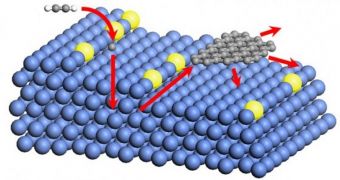Investigators from the University of Cambridge Department of Engineering announce the development of a method for producing graphene that enables the creation of high-quality versions of the material at half the temperature used until now.
With this advancement, it is now possible for a lot more science groups to produce the bi-dimensional carbon compound. Until now, graphene production was limited to a few research facilities around the world that had the necessary hi-tech equipment.
Graphene holds tremendous promises for the future. For example, electrical engineers want to use it to replace silicon in all electronics, simply because the material is an excellent conductor, much better at allowing electrons to pass through than the purest copper.
The Cambridge team arrived at its innovative approach by adding minute amounts of gold on a thin nickel film. They then proceeded to growing graphene sheets on this support. With the help of the gold-nickel alloy, the material can now be produced at only 450 degrees Celsius (842 degrees Fahrenheit).
Until now, the process normally required temperature levels exceeding 1,000ºC (1,832ºF). Cambridge experts Robert Weatherup and Bernhard Bayer were the leaders of the research team. They are also members of the Hofmann research group.
“Only once we’d developed a detailed picture of how the graphene was growing were we able to start tuning that growth and rationally engineering the catalyst – the nickel – to improve it,” Weatherup says.
“Understanding this is interesting from a scientific point of view, but using this knowledge to improve the growth process has been the really useful outcome of our work,” the expert goes on to explain.
Graphene is made up of a hexagonal arrangement of carbon atoms. In its purest form, it is only one atom thick, meaning that it basically has no third dimension (depth). It is the strongest material ever discovered, surpassing both Kevlar and diamond by a wide margin.
“Graphene growth is still a very young field, but it’s moving incredibly fast,” Weatherup explains. Details of the new investigation were published in the latest issue of the esteemed scientific journal Nano Letters.
“Using alloying of the catalyst, as we have here, is a brand new approach in improving the process and we expect further investigation of this will likely lead to improved graphene production, and perhaps at even lower temperatures,” the researcher concludes.

 14 DAY TRIAL //
14 DAY TRIAL //